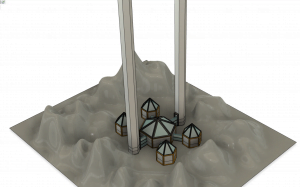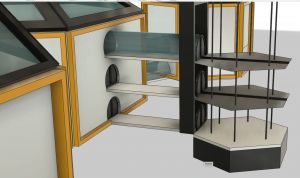Moon Camp Pioneers Gallery 2019-2020
In Moon Camp Pioneers each team’s mission is to 3D design a complete Moon Camp using Fusion 360. They also have to explain how they will use local resources, protect astronauts from the dangerous of space and describe the living and working facilities.
Team: Pulpito 360
IES Viera y Clavijo La Laguna Spain 17 to 18 years old
External viewer for 3d project
|
Project description
[42] |
|||
|
Describe your Moon Camp project.
Our project will basically consist in a subterranean, hexagonal base, since it is a very common structure in nature and brings balance to the base itself. Besides, in order to nourish the base, we have found two practical and ecological ways to extract energy from the sun as well as water, the first method consists in solar panels whilst the second takes the energy from a hydraulic extractor system located nearby the base, moreover, we have built up 4 hexagonal modules nearby the base that fulfill different functions respectively; two of them will accomplish the hydraulic sustenance out of the hydroponic crops. In the other two there will be the machines needed to accomplish the chemical processes that will produce oxygen and recycle water. Where do you want to build your Moon Camp?
The premiere plan was building up the Moon Camp in a 72 kilometer crater called Sirsalis E, located over the western part of the moon, especifically over the coordinates 8.1ºS, 56.5ºW there are many craters with the same nomenclature but this one was chosen due to size motives. This crater has an approximated temperature of 120ºC in the surface; however, in its lower part, the temperature decreases to -350ºC, making a gap of approximately 230ºC in between. We decided to build our base here due to the amount of space available in it, and because its relative nearness to the lunar poles, which will make the process of extracting water and carrying it to the base. How do you plan to build your Moon Camp? Describe the techniques and materials you would use.
Our Moon Camp will be built using techniques required, as well as basic fundamental materials. Firstly, a hole will be dug in the chosen crater, creating an underground gallery in which we will build our base. Then, the base itself will be constructed, by putting into its place individual modular pieces that will be designed to make the process simpler. We will make the outer recoverment of aluminium, as it is a light, malleable material that protects the inner part of the base from external agents. Also, the external surface will be out of titanium, since it is a hard, light, thermal resistant material that has a great resistance against corrosion. In addition, the inside recoverment will be of ceramic fibers that apport defensive properties that enhance the security of the base. To conclude, aluminium silicate will be set in the windows, due to its resistance. |
|||
|
Water
|
Food
|
Electricity
|
Air
|
|
Given the presence of frozen water in the lunar poles, detected in 2009 by NASA and valued in 600 million tons, we can supply that resource by extracting it, being subsequently adapted for human consumption. It will be transported to the base in specialized vehicles, where it will undergo the necessary chemical processes. |
The majority of the food will be produced on the base; therefore, there would be no need to be constantly receiving supplies from the Earth. In one of our modules we will plant a hydroponic crop, with adapted artificial lights and a great variety of vegetables that,besides food, will provide Oxygen. On the other hand, in order to take into account the astronauts’ personal tastes and make the stay as comfortable as possible, large amounts of dehydrated food (meat, molluscs, fish and other bases of the food pyramid) will be carried from our planet. |
The power will be generated by two different methods. The first one will be a parabolic trough, a type of solar thermal collector. The second one will be a hydraulic turbine, which consists of a large process in which a water deposit is installed on the moon surface. The substance will evaporate, sending the vapor through a tube in which a turbine is placed. This turbine will spin, producing energy, and the vapor will reach a second deposit placed in a lunar crater. It will now condense, and go through a second tube with a turbine, reaching the premiere deposit. |
The air in the station will be produced through the Oxygen Generation System (OGS), a system designed by NASA in 2007, which uses electrolysis (a chemical process in which electricity is injected from the renewable energies of the station) uses part of the recycled water to produce oxygen. The water is then divided into Oxygen (O2) and Hydrogen (H2), the first being expelled inside the base and the second being used to produce water (H2O) and methane (CH4), which is expelled into space. |
|
How do you plan to build your Moon Camp? Which materials would you use?
[54] |
|||
|
The environment on the Moon is very dangerous for the astronauts. Explain how your Moon Camp will protect them.
Our base will be located in the lunar underground, thus being protected from the frequent meteoric impacts on the surface. In addition, as we mentioned earlier, the walls of our base will be covered with a layer of ceramic fiber, which is a wonderful electrical and thermal insulator for drastic changes in temperature. On the other hand, to protect astronauts from cosmic radiation, we will use an innovative mechanism based on magnesium diboride superconducting magnets (MgB2), which are able to operate perfectly at high temperatures. These would create some kind of artificial magnetosphere around the station, simulating a mechanism that prevents radiation exposure. |
|||
|
Describe a day on the Moon for your Moon Camp astronaut crew.
To start with, our crew will be formed by 8 members that will accomplish many functions throughout the day. First of all, it is necessary to claim that all of this people will work at a very high capacity level and will have to know how to manage themselves under hard circumstances, as well as they will have to have first aid knowledge. Having said this, the crew will be formed by, at least, two professional astronauts, two doctors (in order to prevent any serious wound caused by either manipulating the material inside the base or external agents that cannot be controlled), and a psychiatrist, due to mental reasons, such as preventing any sort of mental disorder provoked under that circumstances (for instance, claustrophobia, stress or dementia). Moreover, someone specialized in fitness would be a great choice to add up to the crew, since they need to strengthen their muscles in order to not lose muscle mass due to gravity and other outer space agents. Besides, this person will be the premiere responsible of the workout as well as the diet. Likewise, technicians, especially electricians and informaticians would solve many factual issues such as a OS or an electric error in the base; one respectively would perfectly fit in the base and leaving a place for others to fulfill the whole crew. To conclude, a couple of physicists would be needed to calculate distances, to know more about external agents of outer space and how to prevent them.
Secondly, it is also necessary to establish a timetable, in fact, a room has been assigned to accomplish those functions, which is the central one, the timetable or schedule is going to be fitted in a day format; firstly, the whole crew will get up and and have breakfast, then, they are going to work in their respective tasks (which include sample collection of lunar resources, as well as analysing the data, making sure everything works inside the base, etc) during 6 hours with a little 30 minute break in between. After having finished their tasks, they will have lunch. Then, they will workout for an hour and a half. To conclude, the crew will enjoy their deserved free time during 3 hours with activities such as being able to communicate with their families, watching TV series, listening to music, etc. Finally, they will end their routine resting. |
|||






